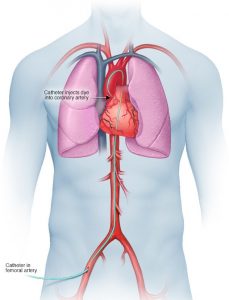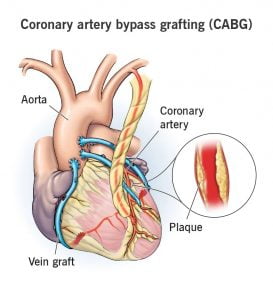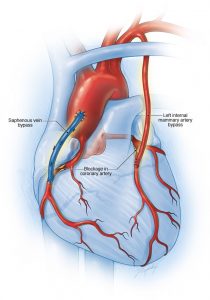Make an Appointment Now
info@macitbitargil.com
Acıbadem Hospitals
Make an Appointment Now
info@macitbitargil.com
Acıbadem Hospitals
Depending on each contraction of the heart, some of the blood is sent to the lungs for oxygenation. Some of it is pumped to the aorta, in other words, to the main artery coming out of the heart.
The aorta is around 3 cm at the point where it leaves the heart and branches out from the left ventricle of the heart. Thus, it undertakes the task of supplying clean blood to the whole body.
The coronary artery, which feeds the heart itself, is the first branch of the aorta. Coronary arteries with diameters ranging from 1 to 3 mm are two, namely right and left. Their job is to feed the heart.
In cases where occlusion or obstruction occurs due to any reason in the coronary artery vessels, which fulfill the function of feeding the heart, undesirable situations such as insufficient nutrition of the heart and inability to perform its normal functions may be encountered.
As a result, the patient is at risk of experiencing chest pain and potentially life-threatening problems such as myocardial infarction, i.e. heart attack.
The surgical procedure performed due to the occlusion of the coronary arteries, that is, the arteries that feed the heart, is called coronary bypass surgery. Within the scope of coronary bypass surgery, blood circulation is restored by transferring veins such as forearm artery, leg vein or thoracic artery taken from the patient to the area, so as not to cause loss of function in the area where they are taken.
Coronary bypass surgery is performed with two different methods. The method by which the surgery will be performed is determined on a patient-specific basis as a result of the evaluations made.
In the stopped valve bypass method, the heart is completely stopped. While the circulation in the body is maintained by a heart pump, the bridging process is carried out. In this method, the heart pump takes over the tasks that must be performed by the patient’s lungs and heart. Thus, while the necessary procedures are carried out, the brain is ensured to pump the blood they need to other organs.
In the bypass method in the working heart, the heart is not stopped. Therefore, it is not necessary to use a heart pump while performing the surgery. The fact that the risk of developing infection is much lower in coronary bypass operation performed with the bypass method in the beating heart is considered an important advantage.
In addition to the methods determined specifically for the patient, it is possible to perform coronary bypass surgery with open or closed surgery, i.e. endoscopic method. Anesthesia is administered after the decision about the method to be applied for the surgery is made and the patient-specific planning is made. Although general anesthesia is generally preferred in coronary bypass surgeries, there is a possibility of performing the surgery under local anesthesia in some cases.
While determining the type of anesthesia to be applied in the coronary bypass method, the general health status of the patient is evaluated. General anesthesia may not be preferred in patients with health problems such as diabetes, hypertension, lung diseases and kidney dysfunction.
There are 3 different treatment alternatives for patients with coronary artery narrowing. These are drug therapy, coronary balloon angioplasty and/or stenting and coronary bypass surgery.
The decision on which treatment method should be applied is determined depending on the patient according to the condition of the disease.
Coronary bypass surgery can be performed:

Like any surgical procedure, coronary bypass surgery brings some risks. The risks of coronary bypass surgery may vary depending on factors such as the patient’s gender, age, lifestyle habits and whether they have chronic diseases.
The risk of loss of life in coronary bypass surgeries is generally low. However, factors such as the age of the patient, the degree of damage to the heart muscle caused by the heart attack, whether the person has a chronic disease, whether there is a loss of function in other tissues and organs, may increase the risk of coronary bypass surgery in particular.
If the patient experiences psychological trauma after coronary bypass operation, it may be necessary to seek psychological support.
After the coronary bypass surgery, when the patient leaves the intensive care unit and the respirator is removed, exercises should be started with the help of a physiotherapist in order to remove the sputum accumulated in the bronchi during the surgery. Under normal circumstances, patients stay in the hospital for 4 to 7 days after coronary bypass surgery. The decision to discharge the patient is made based on the evaluation made at the end of this period.
During the control performed one week after the coronary bypass surgery, the general health status of the patient is evaluated. Complaints are examined and a new regulation is made in the medicines when necessary.
If the patient has chronic diseases such as obesity, diabetes and hypertension, a comprehensive evaluation is made.
It may be necessary for the patient to use compression stockings after coronary bypass surgery. Although it is recommended that patients stay at home during the early recovery period, it is important that they take care not to be bedridden and act as approved by their doctor.
Patients can resume their normal lives at the earliest one month after coronary bypass surgery. During this period, patients may encounter problems such as not being able to drive or turning sideways. It usually takes 6 months for full recovery to occur.
Complete recovery of the patient occurs with the healing of the bone cut during the surgery and the thoracic cage. After this period, patients can continue their normal daily life and business life without interruption.

It is very important for patients to make some lifestyle changes after coronary bypass surgery. After the operation, many patients realize the severity of the coronary bypass operation and the disease. As a result, they are more careful in fulfilling the doctor’s recommendations.
One of the most important issues to be considered after coronary bypass surgery is that if the patient is a smoker, he/she should quit this habit completely. Heavy sports activities should be avoided, attention should be paid to sleep patterns, and if the patient has excess weight, weight control should be ensured with a diet applied under the control of a doctor.
After the surgery, the patient should be involved in daily life as much as possible, as allowed by the doctor. He/she should regularly take the drugs prescribed by his doctor and follow a healthy diet.
It is possible to achieve the desired results in a short time with regular rehabilitation sessions in patients who encounter psychological trauma caused by coronary bypass surgery.
Since sudden changes in a person’s heart rate can cause heart problems, it is important to avoid heavy-duty or very intense and dangerous combat sports.
Swimming can be preferred after coronary bypass surgery, as it is a sport where breathing exercises can be done as well as working out all the muscles in the body. In addition, care should be taken not to interrupt the doctor’s examination after the surgery and to protect the general health status.
All content on the website is for informational purposes only. Consult your doctor for diagnosis and treatment methods.
2022 © All Rights reserved | Design & SEO & Development Simur Digital